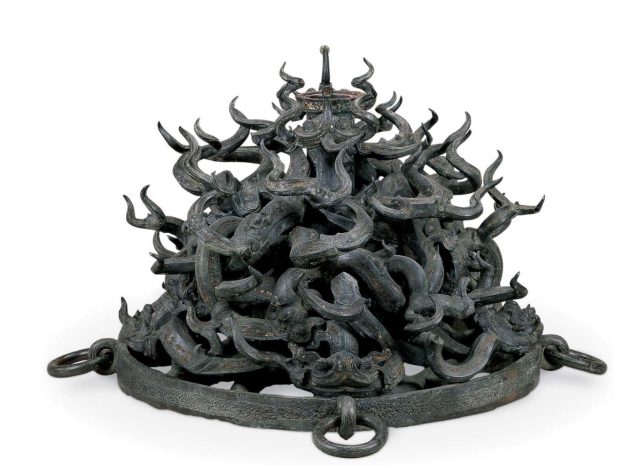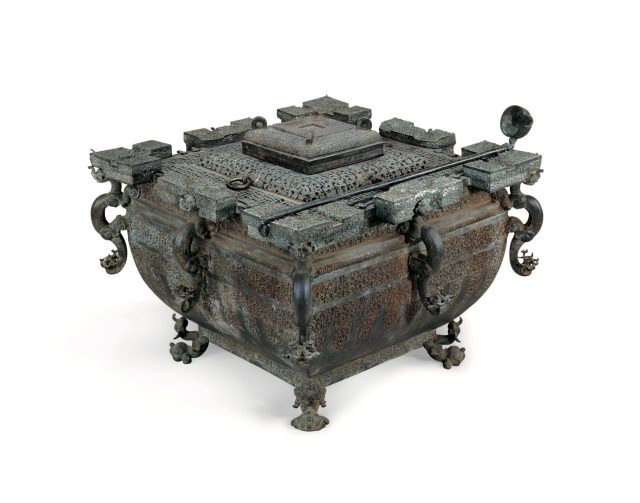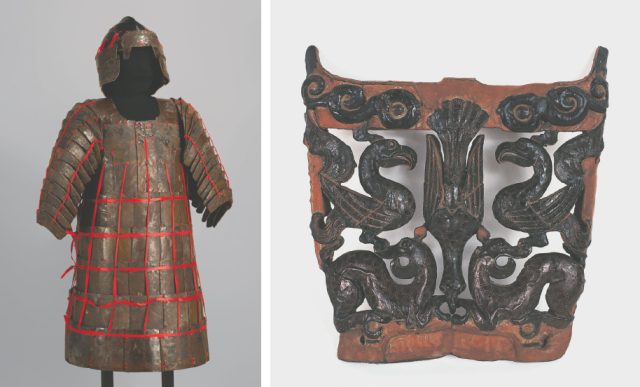Exotic instruments, vessels, flamboyant ephemera in jade and silk, bronze bells and lacquered open-mouthed tigers transport the museumgoer to China’s Bronze Age in The Asian Art Museum’s new exhibit, Phoenix Kingdoms. Phoenix Kingdoms explores the artistic and spiritual in the Zhou Dynasty’s Zeng and Chu Kingdoms through their ritual objects.
The Bronze Age and Its Influence
The Zhou dynasty was obliterated in 221 BCE by the all-conquering Quin Shi Huangdi, the first emperor of China who commanded the creation of the Terracotta Warriors. The cultural influence of this conquered dynasty is now coming into focus in this new exhibition. Dr. Jay Xu, CEO of the Asian Art Museum and a globally-recognized specialist in early China, brings perspective to the scarcity of knowledge about this era. “There were always obvious gaps in the record that never made sense. We knew which states Quin conquered — their historians were delighted to write that down — but what we were missing was the artistic evidence connecting the beliefs of older kingdoms with images that proliferated in later dynasties.” Today, Chinese art is filled with the imagery of phoenixes, tigers and snakelike dragons largely due to the influence of the Bronze Age.
Archaeological Finds
Unearthed from aristocratic tombs, the exhibition reveals the wealth of cultural material from the Ancient Zeng (c. 1040-400 BCE) and Chu (c.1030-223 BCE), both phoenix-worshipping states during the Zhou Dynasty, thriving along the Yangtze River. Before the dawn of the first empire, these were the significant power players of southern China. Through a series of immersive galleries, the materials are contextualized across six categories: jades, bronze ritual vessels, musical instruments and weapons, lacquerware for luxury and ceremony, and funerary bronze and wood objects.

Acting as twin spirit guides on a ritual face covering, a Neolithic jade ornament with a design of two raptors on a mask is the oldest artwork on view (c. 2200 BCE). Sixteen writhing dragons in bronze constitute the base of a drum from the tomb of the Marquis Yi of Zeng (c. 433 BCE). The twisting bodies lead the eye around the extravagant artwork in an attempt to see which tail belongs to which head. The theme of animal worship and mythical beasts continues in the large lacquer-on-wood painted drum with pedestal design of phoenixes on tigers’ backs (c. 300 BCE). Like the other objects, this wooden sculpture’s beautiful sense of symmetry underlines the importance of the animal as deity and rhythmic music in ritual.
Technological Marvels
A bronze double-walled square jian-fou acts essentially as a “wine cooler.” Found in the Marquis’ tomb, this uniquely engineered vessel-within-a-vessel could keep refreshments, such as millet ale, cool for lavish festivities during warm months. The beautifully designed object is perhaps the first metal refrigerator in recorded history.

A lidded bowl and slotted spoon comprises the heaviest gold container yet discovered from early China. The refined workmanship and luxury of gold suggest that the object was reserved for the personal use of the Marquis himself. Gold was traded over long distances and was not prone to tarnishing, rendering it nearly indestructible.
Advancements in Excavation
Objects in Phoenix Kingdoms would not have been possible to present without recent scientific advancements in archaeology and conservation. Advances in technology allow archeologists to safely excavate and preserve fragile organic materials. The waterlogged and therefore anaerobic atmosphere of these ancient tombs means decaying bacteria or chemically reactive oxygen are sealed off from the precious silks, lacquers and woods. Older methods may have crushed or torn the objects, but new techniques mean intricately painted garments and other fragile luxury wares are now resilient enough to leave the ground and travel overseas.
“Many of the extravagant artworks in Phoenix Kingdoms are considered national treasures due to their rarity and their beauty; they are truly ‘missing links’ between myth and recorded history,” says Dr. Fan J. Zhang, exhibition organizer and the Barbara and Gerson Bakar curator of Chinese Art at the Asian Art Museum. Some of the objects in Phoenix Kingdoms have never been seen by the public, and this one of a kind exhibition provides a new understanding of the Golden Age of Chinese art and archaeology.
Sharon Anderson is an artist and writer in southern California. She can be reached at mindtheimage.com.




